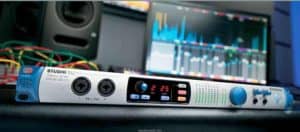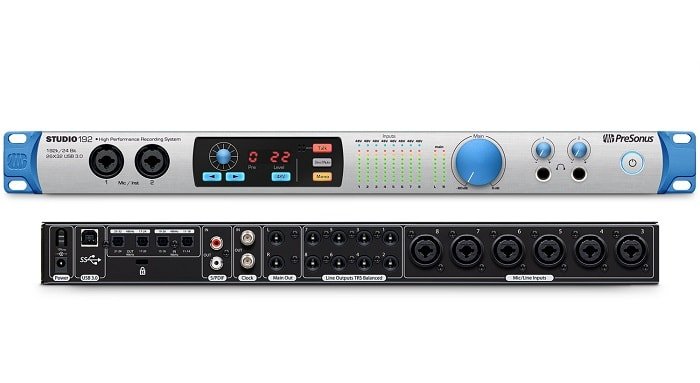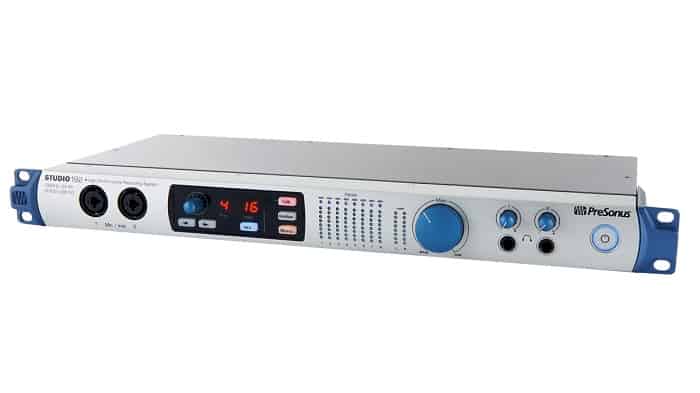 Audio interface hardware has become pretty much standardized by now. The two or four input versions that come in a relatively compact package usually only differ by manufacturer tags they carry, and the color of the case.
Audio interface hardware has become pretty much standardized by now. The two or four input versions that come in a relatively compact package usually only differ by manufacturer tags they carry, and the color of the case.
That is how streamlined these devices are at the moment. There is a good reason for that. The largest portion of the market is looking for those exact features. With that said, there has been a shift in the industry as of recently. So far, the largest chunk of audio interface hardware relied on USB 2.0 to deliver data to your computer.
In most cases that is more than enough. When you look at the bandwidth of USB 2.0, there is loads of headroom to work with, despite the quality of the signal that is being pushed through it. However, manufacturers are slowly beginning to push the envelope, and build their latest models around USB 3.0.
This upgrade relies on technology that is slowly but surely becoming the new standard, and the whole shift is only natural. But does it justify the new and increased cost? Is there really that much improvement in the quality you get when using an audio interface USB 3.0 hardware? Let’s find out.
The Problem
So far the audio interface devices we are used to seeing were able to push a 96 kHz and 24 Bit signal just fine through the USB 2.0. The bandwidth of the Universal Serial Bus that is still standard is more than capable of withstanding that kind of data flow. For the most part, 96kHz is about all that you can need in a home studio environment.
With that said, the bandwidth was never really an issue. What was an issue is the latency that occurs when you start layering VSTi on top of your signal. USB 2.0 has recently been struggling to handle this problem which only prompted manufacturers to up the ante by using different data transfer standards.
One of the these that showed the best performance was FireWire. The nature of FireWire allowed for a significant reduction in latency simply because the way it is designed allows different devices to communicate almost instantly.
 FireWire is rarely used though, while Thunderbolt and USB 3.0 are taking the stage. The problem here is that USB 3.0, while having a much better bandwidth, still suffers from the same problem. In terms of latency and communication between devices, even the USB 3.0 is worse than FireWire, and significantly worse than Thunderbolt.
FireWire is rarely used though, while Thunderbolt and USB 3.0 are taking the stage. The problem here is that USB 3.0, while having a much better bandwidth, still suffers from the same problem. In terms of latency and communication between devices, even the USB 3.0 is worse than FireWire, and significantly worse than Thunderbolt.
So the question is, why choose USB 3.0? Why are the manufacturers turning to a standard that still hasn’t fixed the main issue most audio interface hardware has?
The Solution
The answer is rather simple. USB 3.0 is soon going to be what USB 2.0 is today. From a compatibility stand point, there is no real alternative. USB 3.0 is backwards compatible, so users with old USB 2.0 ports will still be able to use the new hardware, only with somewhat reduced efficiency.
The increase in bandwidth allows you access to 192 kHz territory, which in turn ups the quality of your mix significantly. This improvement alone appears to be the main selling point of new USB 3.0 audio interface hardware like Presonus Studio 192.
Is It Worth The Upgrade?
Just like all new technologies, an audio interface USB 3.0 device will cost you a pretty big chunk of money. Is the price asked for one of these justified? Not really, at least at the moment.
For an average user, a standard USB 2.0 audio interface will do the job more than good. It will take care of anything and everything you could ask for. Yes, the new line of hardware with USB 3.0 offers some improvements that have nothing to do with increased sound quality, but the cost/benefit analysis simply doesn’t justify the price.
 We will definitely see a lot more of these new devices on the market in next couple of years. The new tech will slowly replace the old, and the prices will stabilize. With that said, if you are really looking for optimal performance, USB audio interface may be the wrong kind for you.
We will definitely see a lot more of these new devices on the market in next couple of years. The new tech will slowly replace the old, and the prices will stabilize. With that said, if you are really looking for optimal performance, USB audio interface may be the wrong kind for you.
Devices that use Thunderbolt or FireWire, although very rare, will have a much better performance in terms of latency and ability to transfer the signal to your computer. The only issue with these is that they required specialized hardware in order to be used in any capacity. Not everyone has that. Chances are that you have a Windows based PC, and you would have to buy an additional computer just for recording purposes.
For enthusiasts this is often a deal breaker. If you are serious about recording, the type of gear you will be using transcends the plain of audio interface devices anyway. Having said that, the options are very limited at the moment as you can probably imagine.
Everything considered
Audio interface USB 3.0 devices are just a slight improvement over the existing ones we have at the moment. The question of whether this upgrade can even be justified is completely valid. You are expected to pay a whole lot of money for an increase in signal quality.
If these devices offered more than just that, the situation would probably be a lot different. As things stand today, using a USB 2.0 audio interface is still the standard, and it will remain that way for a while.
The tone of this article may have come across as too conservative. The reality is that the evolution of technology isn’t really advancing at the pace we expected. Whether this is a good thing or not, or whether it’s somehow related to us hitting a ceiling remains to be seen.
Maybe USB is the wrong choice in general. But since it is so spread out, we probably won’t see another standard taking its place any time soon.

